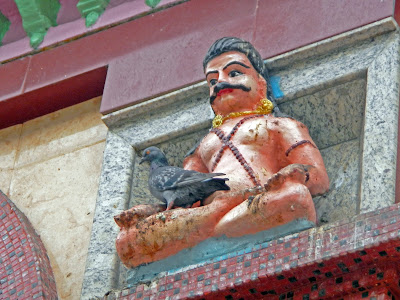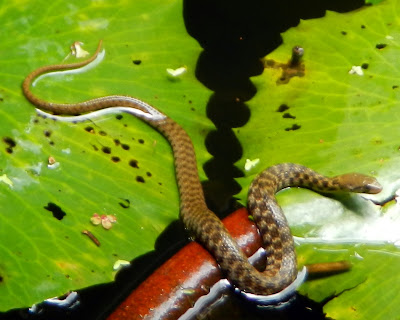searching for nature in Yangon, Part One
You don’t have to go to the countryside to get a nature fix. Wherever I go I look for plants and animals. Just like rural spaces, cities consist of a series of ecosystems, in which humans, plants and animals interact. The culture of a society affects how animals and plants are perceived and treated, so this is one way of helping me understand the beliefs and practices of the people around me.
This was my focus in exploring Yangon (Rangoon), the former capital of Myanmar (Burma).
 |
| Shwedegon Pagoda |
Yangon is changing - fast. It is barely two years since the military junta relaxed its authoritarian grip and introduced an era of greater freedom and liberalization. This led to the lifting of sanctions and with it, the veil of isolation. Enter the developers, with their promises of progress and wealth, and enter the environmental challenges and threats that go with development.
 |
| The old and the new side by side |
It's not all so beautiful though. I saw the largest rats I've seen ever in Yangon. Many of the footpaths are broken and in disrepair, and there are open drains as well.
The Betel Nut Palm, or Areca Palm, is a small palm tree widely cultivated throughout the country. It is native to Malaysia. Chewing betel nuts is a traditional social custom throughout Myanmar as well as many parts of Asia.
In Myanmar the betel nuts are chopped into small pieces and mixed with spices, such as clove and nutmeg, then wrapped in a leaf from the betel pepper vine (Piper betel). Many people set up stalls along the streets of Yangon, making up the packages to order, and selling them.
Chewing the nuts, I am told, gives a euphoric feeling. It also stains the mouth and teeth bright red, and has been found to be a carcinogenic. Often people in the street spit bright red gobs of betel nut juice.
Of all birds, pigeons must surely win the urban survival stakes. I've never seen as many pigeons as in downtown Yangon. Particularly around the Sri Kali Hindu Temple.
The race is on to try to save the gracious old colonial buildings from the bulldozers. One building has been preserved by turning it into a boutique hotel. As a special treat we stayed there for a couple of nights. I didn't care about the service, comfort or food. I stayed there because of the beautiful garden, in which my camera and I went on a bit of a rampage.
These tiny frogs lulled me to sleep each night with their loud calls. Apparently only male frogs make these sounds, in order to attract females of the same species. And apparently the rainy season is the breeding season.
I tend to think snails don't get the interest and respect they deserve. This snail, covered in its protective slime, is far more delicate and attractive looking than the common old garden snail. Identifying snails is very tricky. Shell colour, shape and markings, as well as body colour and markings, vary among individuals of the same species. So you need a combination of things, and even then, it's only to narrow down the range of possibilities. It's doing my head in ... so, enjoy this snail, that I am taking the liberty of naming Helix boutiquehotelus.
There are lots of poisonous snakes in Myanmar, but I don't think this little beauty was anything to worry about. It was a member of a family of water snakes living in one of the ponds in the garden. They were very small and inconspicuous - this photo was enlarged to show the chequered markings on the skin. Unidentified. But it knows who it is.
Some of the plants in the garden were unfamiliar, some were familiar to me as indoor plants and some were familiar from the blogs of friends like Stephanie, who gardens in the Southeast Asian region.
This was a flowering grass growing in the water. It is highly magnified. I love the way it dresses in pink and white bows and green hairy caps.
This is a Heliconia, one of a group of tropical plants with large leaves and colourful flowers.
In the garden was a group of broad leaved foliage plants, artfully placed so the light and shadows played on their leaves in changing patterns throughout the day. This would never happen with indoor plants!
Banana trees are common in Myanmar, both cultivated and wild. This is the banana flower.
The garden reflected in the swimming pool ... serenity at a price.
Lovely orchids in the garden ... I think this is Phalaenopsis cornu-cervi, an epiphytic orchid native to the region. In the wild it is found in lowland forests. This species appears to have been domesticated for garden use.
In the second (and last) post on searching for nature in Yangon, I visit a market and take a long train ride around the city and into the surrounding countryside.

























Wow, so many pigeons! They never show any respect for my garden either. The snail, snake and frog are beautiful.
ReplyDeleteThanks for the visit and comment, Denise. I think I might make up a story for the children: Once upon a time a snail, a snake and a frog lived in a beautiful garden in a faraway land ...
DeleteI would have enjoyed walking through that tropical garden,it looks beautiful, I love the shot of the garden reflected in the water.
ReplyDeleteThanks Karen, I took lots of photos of the reflections in the water, it was hard to choose one to put in the post.
DeleteThis looked to be a quite an adventure full of botanical and critter surprises:) I know what you mean about it all "not looking so nice". These little trips are exciting as they reveal much about the greater world. As for the pigeons.......
ReplyDeleteDear Chris, I guess travelling for me is always an adventure full of botanical and critter surprises because that's what I'm looking for. The not so nice bits are usually more interesting than the nice bits.
DeleteIt sounds like an amazing experience !
ReplyDeleteI do like the iridescence of Helix boutiquehotelus. Very pretty and delicate. Definitely the nicer looking cousins of the common brown striped variety in this neck of the woods :-)
The snakes were actually very small and hard to spot in the water. I pointed them out to people who worked there, they were surprised, they had never noticed them.
DeleteHi Catmint. It's easy to forget, in settled surroundings, how nature has to make its way around our new developments. It's a pity that it's still regarded, most of the time, as peripheral.
ReplyDeleteIt must have been an interesting trip, with surroundings so different to home. Has it inspired you to create a tropical corner?
Hi Faisal, it was an amazing trip, it was such a different culture to home, I definitely want to go back some time. I would never want a tropical corner though in my garden. I'm trying to get a garden that is naturalized, and our climate, as you know, is extremely un-tropical.
DeleteInedible images and words. I can't get the giant rat image out of my head though. You had an amazing trip! Thanks for taking us along!
ReplyDeletepleasure, dear og ...
DeleteI really hope there is an urgent sense of preservation and conservation at work in Myanmar. Earth doesn't need another concrete jungle or more giant rats. I would have escaped into that lush garden, too.
ReplyDeleteHi Tammy, it's like anywhere else, some people are into conservation, and some into ruthless development. Hopefully there'll be some sort of comprimise, but usually the developers have more power ...
DeleteThis is one of the most fascinating posts I've read/seen in a long time! I thoroughly enjoyed it! I had heard about the Betel Nuts, but I didn't know they were carcinogenic. All the plants you show are stunning--and that snail is luminous on the leaf! Sounds like a place of many contrasts. I hope the garden areas can be preserved. Thanks for taking us along for a visit!
ReplyDeletethank you, Beth, for such a compliment.
DeleteSue catmint, another lovely post! Not because I was mentioned here (hehe....)... it is really a good one. Those betel nuts, I think I would never taste it in my life... don't want to have my teeth and mouth all red haha... I went straight to the airport from Pyin Oo Lwin and missed Yangon. These pics tell me that Yangon is a bigger city now. But hey, those frogs and snakes... gosh they were there? Where were you staying? Frightening snake aside, I like the garden (so beautiful!). Hope you don't mind me asking ;-) You have a great weekend!! Cheers, Stephanie
ReplyDeleteHi Steph, I wouldn't want my teeth and mouth all red either. I've been reading about Pyin Oo Lwin, and want to go there next time. I think such tiny frogs and snakes are probably commonly found in water round there, but often hard to spot. I'm so pleased you liked the post.
DeleteI'd like to know what you meant by "The garden reflected in the swimming pool ... serenity at a price."
ReplyDeletehi Linda, I meant it was a hotel garden, you had to pay to see it.
DeleteI'm really enjoying reading all about Myanmar and seeing it through your lenses - especially the underwater photos!
ReplyDeletedear Bubbles, the best bubbles are to be found underwater (ancient Chinese proverb)
ReplyDeleteWow how interesting the old and the new...the same cycle happens in many cities around the world. I do hope they preserve the old...such beauty lost would be a tragedy. Love that garden.
ReplyDeleteHi Donna, there is definitely a push to conserve the lovely old colonial buildings. Hopefully they will find some kind of balance, change can be so sad ...
DeleteThat is more pigeons than I ever saw in New York City and that is saying something. Yipes! I enjoyed your tour and how you perceived your visit. It is true how cultures treat their plants and animals says quite a bit about them. I agree, that snail is beautiful in its own way. I like the name you gave it too. The snake is very pretty. Snakes often are, but they still scare me.
ReplyDeleteHi Donna, that snake looks much bigger in the photo than it was in reality. I'm more scared of those yellow and black wasps in your garden than most snakes, because those wasps are aggressive and most snakes I am aware of will only attack if they feel trapped.
ReplyDelete